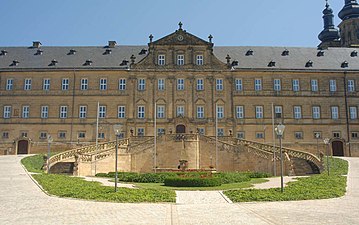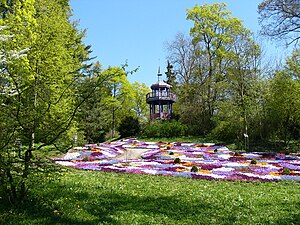 | |
| Upper Franconia | |
| Capital | Bayreuth |
|---|---|
| Residents | 1.062.398 (2016) |
| surface | 7,230.19 km² |
| website | www.region-oberfranken.de/ |
| no tourist info on Wikidata: | |
| location | |
 | |
Upper Franconia is an administrative district in Franconian part Bavaria and is also known as the beer franc. There are around 250 to 300 small and medium-sized breweries in Upper Franconia. The focus of the breweries is in the triangle Bayreuth, Nuremberg and Bamberg.
Regions

The touristic-oriented division of the region is as follows:
- Coburg country - the area around Coburg in the northeast belonged to until 1919 Thuringia.
- 1 Fichtel Mountains - Central mountain range in the east with the highest mountains.
- 2 Franconian Forest - Low mountain range in the north with a smooth transition to Thuringian Forest.
- 1 Franconian Switzerland - Karst area with climbing rocks, castles and caves in the south.
- Hofer Land - between the Fichtel Mountains and the Franconian Forest in the Saale Valley around the independent city court.
- Upper Mainland - from the confluence of the two source rivers of the Main at Kulmbach to Bamberg.
places
The old town hall in Bamberg

The market square in Coburg, east side
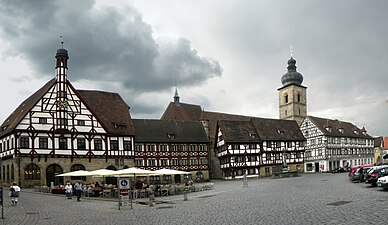
The market square in Forchheim
Marienkirche and old town in Hof
- 1 court
 - City of culture and film as well as a former royal seat
- City of culture and film as well as a former royal seat - 2 Kronach
 - City at the foot of the Franconian Forest; Veste Rosenberg towers over Kronach, one of the best preserved fortifications in Europe.
- City at the foot of the Franconian Forest; Veste Rosenberg towers over Kronach, one of the best preserved fortifications in Europe. - 3 Coburg
 - Former royal seat with the fortress Coburg.
- Former royal seat with the fortress Coburg. - 4 Lichtenfels
 - Railway junction in the Upper Mainland; Catholic Parish Church of the Assumption
- Railway junction in the Upper Mainland; Catholic Parish Church of the Assumption - 5 Kulmbach
 - the beer town on the White Main with its landmark, the Plassenburg.
- the beer town on the White Main with its landmark, the Plassenburg. - 6 Wunsiedel
 - District town in the Fichtel Mountains, known for the Luisenburg Festival.
- District town in the Fichtel Mountains, known for the Luisenburg Festival. - 7 Bayreuth
 - Richard Wagner Festival.
- Richard Wagner Festival. - 8 Bamberg
 - the historic city center is a UNESCO World Heritage Site.
- the historic city center is a UNESCO World Heritage Site. - 9 Forchheim
 - old royal city and imperial palace; the "entrance gate to Franconian Switzerland".
- old royal city and imperial palace; the "entrance gate to Franconian Switzerland".
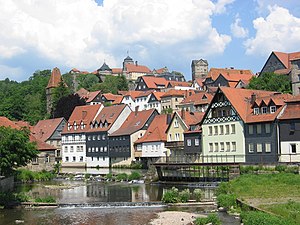
The three-tier cityscape of Kronach

The Kulmbach market square

The market place of Lichtenfels

Downtown Wunsiedel
Other goals
- 3 Red Main - from the confluence with the White Main near Kulmbach to the source at Cussen
- 4 White main from Bischofsgrün im High Fichtel Mountains to the Mainz confluence near Kulmbach
- The Upper Franconian Medicinal baths1 Bad Rodach
 , 2 Bad Steben
, 2 Bad Steben , 10 Bad Staffelstein
, 10 Bad Staffelstein , 3 Bad Berneck
, 3 Bad Berneck and 11 Bad Alexandersbad
and 11 Bad Alexandersbad present themselves together as The 5 KurFranken with a comprehensive health and wellness offer.
present themselves together as The 5 KurFranken with a comprehensive health and wellness offer.
- At 12 Kasendorf
 became the geographic center of Upper Franconia set. The spot is marked with a sculpture in the form of a steel vortex.
became the geographic center of Upper Franconia set. The spot is marked with a sculpture in the form of a steel vortex.
- At 13 Pettstadt
 there is the only one Yaw ferry in Upper Franconia, which runs a little east of the village over the Regnitz. It operates from spring to autumn and is a popular station for hiking and cycling trips.
there is the only one Yaw ferry in Upper Franconia, which runs a little east of the village over the Regnitz. It operates from spring to autumn and is a popular station for hiking and cycling trips.
- The market town 14 Küps
 is known for its high Locks density, There are eight castles for every 8,000 inhabitants in the municipality.
is known for its high Locks density, There are eight castles for every 8,000 inhabitants in the municipality.
- The community 15 Aufseß
 is in the Guinness Book of Records with 330 inhabitants per brewery, the highest Brewery density of the world.
is in the Guinness Book of Records with 330 inhabitants per brewery, the highest Brewery density of the world.
- Also the Mining in Upper Franconia has left its mark for centuries
Pettstadt ferry
The center of Upper Franconia at Kasendorf
nature
- The 1051 m high Schneeberg and the 1023 m high Ox head in the Fichtel Mountains.
- The Luisenburg rock labyrinth with huge granite blocks Wunsiedel in the Sechsämterland
- The Devil's cave at Pottenstein (Upper Franconia)who have favourited Bing Cave Streitberg and the Sophienhöhle in Maple Valley
- The Hell Valley at Bad Steben and the Kleinziegenfelder valley Weismain
- The Green ribbon is the first all-German nature conservation project and was created along the former inner-German border strip, it runs along the northern borders of Upper Franconia.
background

In Bavarian communities with predominantly members of the Catholic Church is according to the law Assumption Day (August 15) a public holiday. This applies to all municipalities in Old Bavaria and to around half of the Franconian municipalities. For planned activities and shopping, you should inquire beforehand whether there is a public holiday at the holiday destination.
Holy mountains
There are three mountains that are sacred to Upper Franconia. The mountains, which were already populated in prehistoric times Walberla at Kirchehrenbach and the Staffelberg at Bad Staffelstein as well as the Kreuzberg at Hallerndorf with the pilgrimage church built in 1463 and the beer cellars of three breweries.
regional customs
The Drink strong is an ancient custom, which started on the eve of January 6th or on 6th January itself takes place. The "strength" means health and strength for the new year to arm yourself against future adversities. For this reason, a number of breweries offer strong beer, also known as bock beer, which often ends in -or z. B. Markator (Schinner, Bayreuth) or Mobilator (Gottmannsgrüner Brewery). In many inns there are special offers and dishes to drink a decent strength.
Easter
- In earlier times the karst plateau was dominated by the Franconian Switzerland frequent lack of water. Every spring it was hoped that the wells and springs would not dry up over the course of the summer. For this reason, at some point in the time before Easter, the fountains and springs were cleaned and festively decorated. Meanwhile in many villages in Franconia Easter fountain adorned again.
- The Easter fountain in Bieberbach at Egloffstein is the largest in the world. It has been entered in the Guinness Book of Records with 11,108 hand-painted eggshells. The fountain is decorated every year from Palm Sunday until about three weeks after Easter.
- In the Adelgundis Chapel on the Staffelberg Bad Staffelstein becomes one every year during Easter until the end of May Easter crib issued. It shows the Holy Sepulcher and movable groups of figures show the suffering of Jesus, his death and the resurrection.
- On Holy Saturday from 2 p.m. there is the custom of Egg whale in Naila. The aim is to let a hard-boiled egg roll down the "Walchhang" as far as possible undamaged. There are medals and prizes for the best "race eggs". The winner gets to keep all eggs from the competition. There is also a competition class especially for holiday guests.
.jpg/338px-Bieberbach_Osterbrunnen_2018_(3).jpg)
Easter fountain in Bieberbach in Franconian Switzerland
.jpg/338px-Adelgundiskapelle_Staffelberg_Osterkrippe_2018_(1).jpg)
The Easter crib in the Adelgundis Chapel
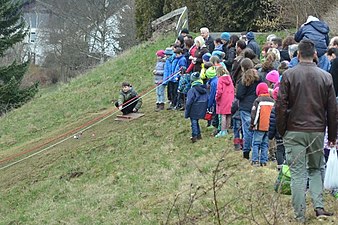
Egg rolling in Naila
language
In Upper Franconia you can find the variety of Franconian dialects. Pronunciation, grammar and terms change from village to village. The "broad board" is called, for example, in the Franconian of the Franconian Forest and the Hofer and Bayreuth area as "braads Breed" and in the "Itzgründischen" of the Coburg country as "brääds Bradd".
Half a liter of beer is commonly called "Seidla"Ribs can also be found on the menu as" Rippla "(pronounced ribbla).
In the Bamberg area you don't go to the beer garden, but "nauf'nan Kella" (up to the cellar). This has its origins in the beer storage cellars, which were mostly dug into a mountain outside the village. At some point someone came up with the idea that it is easier to pour the fresh beer straight from the storage cellar in summer than to transport it to the beer drinkers in the village. Over time there are many former Beer cellars wonderful beer gardens emerged, to which one goes ´up into the cellar´.
There are different dialects in the Hofer Land. They speak mainly Upper Franconian, but in the north people speak Vogtland. The Vogtland also had an influence on the Franconian in Hofer Land. Often a sound is used between o and a. When two people are talking and one is talking, the other keeps saying "hoa", which is synonymous with "aha". If the customer then agrees, he replies “na scha”, like “yes yes”.
getting there
By plane
The closest international airport is the ![]() Nuremberg Airport
Nuremberg Airport![]() (IATA: NUE)
(IATA: NUE)
In the street
The following motorways run through or to Upper Franconia:
 Autobahn 9Berlin - Triangle Bavarian Vogtland - Triangle Bayreuth / Kulmbach - Munich
Autobahn 9Berlin - Triangle Bavarian Vogtland - Triangle Bayreuth / Kulmbach - Munich Highway 70Schweinfurt - Bamberg junction - Bayreuth / Kulmbach triangle
Highway 70Schweinfurt - Bamberg junction - Bayreuth / Kulmbach triangle Highway 72Chemnitz - Triangle Hochfranken - Triangle Bavarian Vogtland
Highway 72Chemnitz - Triangle Hochfranken - Triangle Bavarian Vogtland Highway 73Nuremberg - Cross Bamberg (-Suhl)
Highway 73Nuremberg - Cross Bamberg (-Suhl) Highway 93regensburg - Dreieck Hochfranken
Highway 93regensburg - Dreieck Hochfranken
mobility
The OVF - Omnibusverkehr Franken runs throughout Upper Franconia, details about routes, timetables and prices can be found on the Internet OVF.
The runs every Saturday evening Leisure bus the popular discos and dance halls in the district of Bayreuth.
The China route runs through Upper Franconia and the northern part Upper Palatinate along the sites of porcelain production, such as porcelain factories, factories, studios, specialty museums and factory sales.
Also the Castle Road leads across Upper Franconia from castle to castle.
Tourist Attractions
- In Bamberg There are over 1000 houses under monument protection, most of the city center is also part of the
 UNESCO World Heritage Site.
UNESCO World Heritage Site.
- The 5 Fourteen saints
 and the 6 Banz Monastery
and the 6 Banz Monastery in the valley of the Obermain.
in the valley of the Obermain.
- The lock Weissenstein at Pommersfelden, one of the main works of the South German Baroque.
- Ebrach with the former baroque Cistercian abbey and the Gothic-Early Classicist abbey church
- court with the Neustadt in Biedermeier style, whose ensembles are under monument protection, as well as with the Theresienstein.
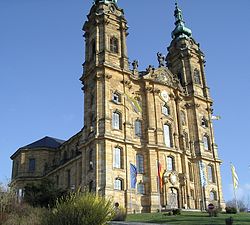
Pilgrimage Basilica of the Fourteen Saints
Former Banz monastery

Weissenstein Castle
Ebrach monastery church
Thomashöhe at Theresienstein in Hof
The artificial ruin in the labyrinth in Hof
The margraves have a large number of them Tourist Attractions leave:
- In Bayreuth the Hermitage and the Margravial Opera House, it is considered one of the most beautiful baroque theaters in Europe and was named
 UNESCO World Heritage Site accepted.
UNESCO World Heritage Site accepted.
- The Fantaisie Palace Park with garden art museum is located in Eckersdorf 5 km west of Bayreuth.
- The rock garden Sanspareil at Wonsees

Margravial Opera House

Fantaisie Castle
Sanspareil
activities
Major regular events
- On January 6th on Epiphany is in Pottenstein traditional one Festival of lights celebrated.
- first weekend in May: Bergkerwa on the Walberla at Kirchehrenbach
- Sunday after Corpus Christi - Swedish procession in Kronach
- June - Well festival in Wunsiedel
- The International Samba Festival takes place in Coburg at the beginning of July
- End of July (10 days around July 26th) Anna Festival in Forchheim
- End of July - „Beer week“ in Kulmbach
- Late July to early August that Hofer Volksfest
- August - "Free shooting" in Kronach
- Bamberg at the end of August Sandkerwa
- September - Basket market in Lichtenfels
- End of September - autumn market in court
- In summer the High Franconian Games with unusual sports instead.
Culture
- July to August - the world famous Richard Wagner Festival in Bayreuth
- June to August - „Luisenburg Festival“ in Wunsiedel
- October - Hof International Film Festival in court
- The Franconian theater summer is a "wandering open-air theater" that travels the Franconian Switzerland region all year round with a small ensemble in the style of medieval vagabond stages.
- The Trebgast natural stage, Trebgast, has developed into an artistic gem and is called the most beautiful amateur natural stage in Germany. From May to August she offers four of her own pieces and various guest performances.
- The Theater courtyard is a four-branch theater and, with 330 performances, is the second largest theater in Upper Franconia after the Landestheater Coburg.
- The Bayreuth studio stage is not only known for its Wagner parody at the festival time, it offers a varied program at various venues all year round.
The stage of the Luisenburg Festival

Hof Film Festival

The studio stage plays in the ruin theater in the Bayreuth Hermitage
Parish fair
During the warm months there is always a church fair (Kerwa) somewhere. The parish fair often begins on Thursday, when it is 'dug up'. On Thursday there is "horseradish meat" (boiled meat with horseradish sauce and dumplings), on Friday there are pork dishes: blood and liver sausages, press sacks, meat platters or roasts. With coffee there is "Küchla", the Franconian lard pastry that differs from place to place. On Saturday and Sunday there is a real celebration, either in the village inn or in a marquee, with brass and / or rock music, often with a parade. Monday is "Nachkerwa", often with a rock concert, and on Tuesday the parish fair is again ´dug in´ until next year. On the third Sunday in October, the all-world church consecration takes place in many villages.

Lindenkerwa in Peesten
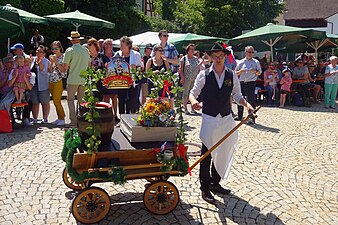
Beer and beer mugs are transported on the cart.
Hiking and pilgrimages
- Various Way of St. James run through Franconia. Two main routes lead through Upper Franconia, from Erfurt via Coburg, Lichtenfels, Bamberg to Nuremberg, or from Hof via Bayreuth to Nuremberg.
- 54 Brewery tours which lead past at least one brewery, with a total length of over 1000 kilometers, with 32 hikes, 17 bike tours and 5 car tours, there are tour maps for printing and GPS tracks for downloading.
- Upper Franconia is an ideal hiking region. The Rennsteig leads a piece through Upper Franconia and the Frankenweg begins here. Some suggestions for hiking in Upper Franconia can be found in the Wikibook Kronacher excursions.
kitchen
There is detailed information on Franconian cuisine in general in the separate topic article Eating and drinking in Franconia, to the beer Breweries in Franconia and to liquor in Distilleries in Franconia.
Upper Franconia holds 3 culinary records, based on the number of inhabitants, there is a bakery or confectionery for every 2,080 inhabitants, a butcher's shop for every 1,540 inhabitants and a brewery for every 5,511 inhabitants. More information about enjoyment in Upper Franconia can be found at Enjoyment region Upper Franconia.
You can find them on every menu in inns Snacks (snacks, vespers, etc. elsewhere). The main ingredients are often homemade sausages, such as Göttinger or red and white press sacks. When it comes to cheese, there is often "Backstakäs" (Limburger) or "Ziebeleskäs" (curd cheese), also known as "White Cheese" or something else. An important ingredient is the ham, often referred to as smoked meat, black meat, or in the Bamberg area as "plum bammes". A side dish to the snack is bread, preferably home-baked.
- Roast with "Gliis" (dumplings, itzgründisch: "Glüëß")
- "Ei'gschniedna Gliis" (finely sliced dumplings from the previous day roasted in scrambled eggs)
- Roulades
- Schäuferla (Pork shoulder)
- Schüpf or Schipf, or slaughter bowl, denote kettle meat
- Beer from small craft breweries
Schäufele
Beef pot roast
Incised dumplings
Sausages
The Coburger is the largest at 25 cm, the coarse fullness in the pig intestine is usually roasted over an open pine cone fire, which gives the special aroma. It is also the only one that is eaten individually, all other Upper Franconian variants are enjoyed in pairs. The sausages in the Forchheim area are just as coarse, but smaller, and medium-sized in the Bamberg, Lichtenfels and Kronach area. Fine sausages, rather long and thin, are available in the areas around Hof, Bayreuth and Kulmbach. The latter is served in the bratwurst stollen, a long roll with lots of aniseed. Whether mustard or not, everyone has to decide for themselves, if mustard, but then the seven-star mustard Oberkotzau. In the tavern you usually get the sausages with sauerkraut, but there is also the variant in onion stock, called blue tails or blue soot.
Fine sausages with sauerkraut
Coarse sausages in a roll with mustard

Coburg sausages
security
In regularly published police statistics, Upper Franconia is shown as the administrative district in Bavaria with the fewest criminal offenses per inhabitant. In terms of security, Bavaria is one of the leaders in the national average.
health
- nationwide On-call number 116 117 (free of charge)
- Emergency services in Upper Franconia: Tel. 01805/191212 (14 cents / min. From the German landline network, cell phones max. 42 cents / min)
climate
The climate in Upper Franconia is often different from what Bavaria said on the radio. It is helpful to also have a look at the weather forecast for Thuringia. This is especially true for the northern part. There is a not insignificant difference between the southern Hofer Land and the northern Fichtel Mountains, which have a rather harsh climate (jokingly: "Bavarian Siberia") and the milder climate on the Main. In the city of Hof itself, the temperatures are often higher than in the rest of the Hofer Land.
literature
- Wolfgang Judas: fei (n) Franconian, The best aspects of a region full of unique worlds of pleasure, Verlag Druck & Medien Heinz Späthling, 2010, ISBN 978-3-926621-85-6
- Ralf Nestmeyer: Francs. A travel guide. Michael-Müller-Verlag, Erlangen, 4th edition 2007. ISBN 978-3-89953-278-4 .
- book Kronacher excursions on Wikibooks with hikes and bike tours in the district of Kronach and the surrounding area
Web links
- http://www. Bezirk-oberfranken.de/ - Official website of Upper Franconia
- Upper Franconia - A government district introduces itself to the map
- Upper Franconia culture atlas














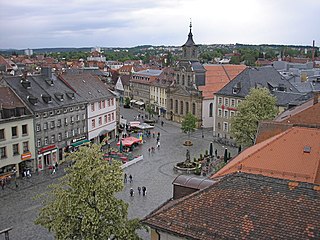
_10.JPG/350px-Altes_Rathaus_(Bamberg)_10.JPG)









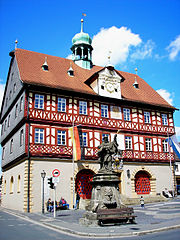








.jpg/338px-Bieberbach_Osterbrunnen_2018_(3).jpg)
.jpg/338px-Adelgundiskapelle_Staffelberg_Osterkrippe_2018_(1).jpg)





